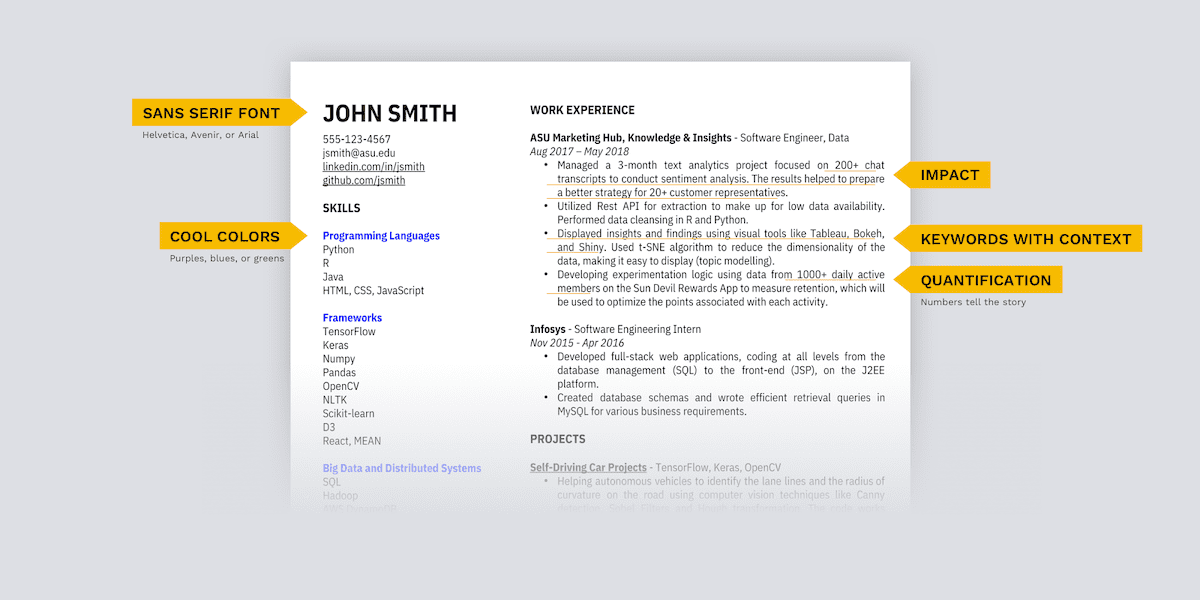As you’re nearing the end of a coding bootcamp and beginning your job search, you should make sure your software engineer resume is as strong as possible. It’s an extremely competitive landscape, with hundreds and sometimes thousands of people applying for the same new grad software engineering positions. Recruiters look at resumes for less than a minute, and often that is after they are parsed by an applicant-tracking system (ATS).
We’ve worked with hundreds of software engineers to optimize their resumes so they make it past the ATS and the first glance recruiter and move forward with next steps. Here are our top tips.
1. Start Your resume Statements with Strong, Action-Oriented Words
If you’ve just finished a coding bootcamp, odds are that most of the items on your resume are going to be related to websites or apps you developed in the program. Maybe you have some internship experience as well, which is likely similar to the type of work you were learning or practicing in your bootcamp.
But that doesn’t mean you can start every sentence with “Developed,” “Coded,” or “Programmed,” because those words won’t excite or interest the recruiter. Of course, they want to know if you can code, but they also want to know more about what you did.
Here are some examples of strong resume sentence-starters:
- Led a team of…
- Spearheaded design and development for…
- Accomplished project goal of…
- Established new system by…
- Organized team and…

2. Quantify Your Impact
When you’re describing your projects and experiences, make sure your statements are impact-forward. Avoid explaining the grunt work you did–like, “Developed X for Y.” Instead, focus on why and how you did it. What was the impact of your work? What results did you achieve?
If you’re having trouble quantifying the results because the project didn’t launch, the audience was small, or the goal wasn’t reached, don’t worry! Ask yourself some of these questions to come up with some numbers to include:
- What was the scale?
- How many devices did I serve?
- How many scenarios/permutations/tests did I consider/handle?
- How many different methodologies did I implement?
- What did I results did I achieve?
- How many users did I launch to or will I launch to?
- How many users/groups used it?
These resulting statements should look more like, “Spearheaded X by implementing Y, which led to Z.” For example, “Spearheaded a Waze-like app for Pokemon Go players by implementing Ruby on Rails, which led to 40% time saved on finding Pokemon.”

3. Highlight Your Technical Skills
Prospective employers will look at your resume for six seconds to one minute, or potentially have it parsed through an ATS, so you need to do everything you can to make sure it matches the job description exactly, wherever you can.
Create a designated “Skills” section, so when a recruiter is glancing at your resume, they will see it immediately. Tailor your resume specifically to each job to directly match the job description. Applicant-tracking systems, and sometimes human recruiters, are looking for those words, and won’t recognize a partial match. For example, if the job requires experience in “Ruby on Rails,” and you just have “Ruby” on your resume, it won’t pick it up. Similarly, if past experience is required as a “Systems Software Engineer,” and you have “Software Engineer, Systems,” you need to make it match!

These tips are just the beginning. We have an annotated, editable software engineering resume you can use to optimize and enhance your resume. Then, you can begin sending cold emails to hiring managers and recruiters with the knowledge that you’re sending an extremely strong resume. Our fellows have seen their application responses triple after updating their resumes with these examples and sending out compelling cold emails.
If you’re interested in working with an advisor 1-on-1 on your job search, become a Pathrise fellow.
About us: Career Karma is a platform designed to help job seekers find, research, and connect with job training programs to advance their careers. Learn about the CK publication.

